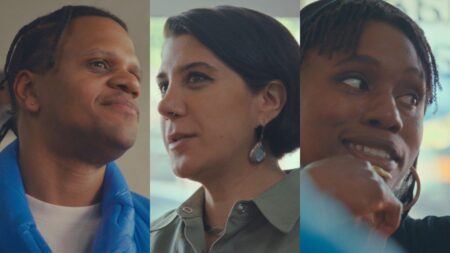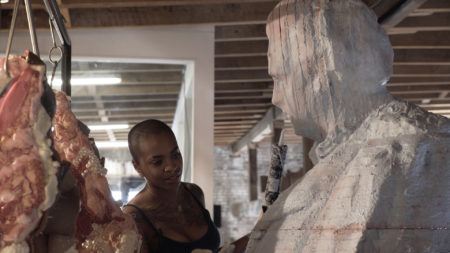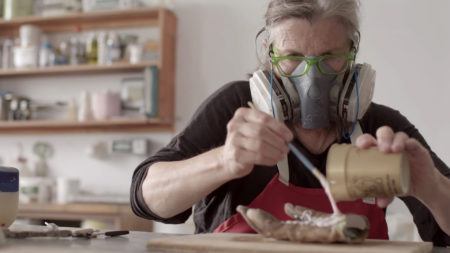Interview
Teaching History by Sculpting Experience
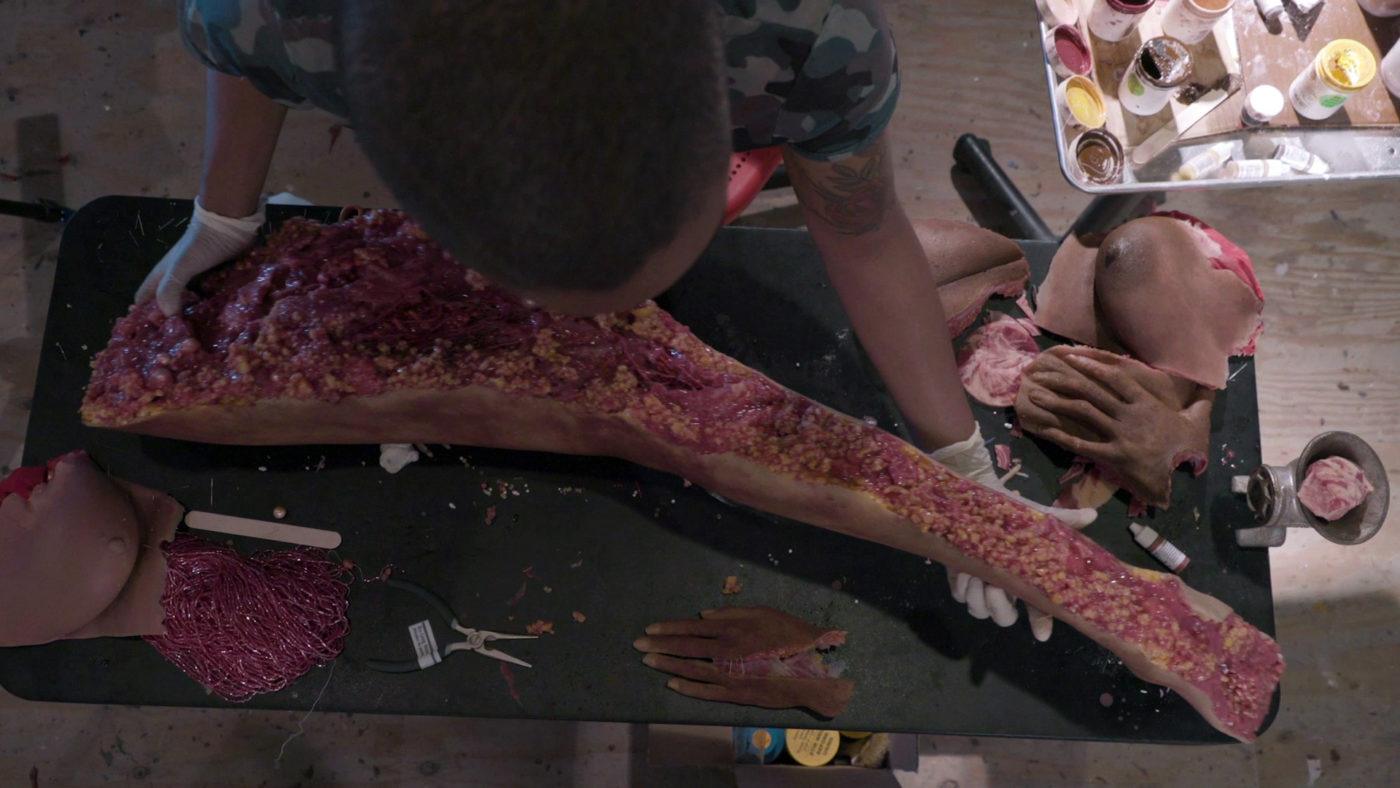
Doreen Garner at work on White Man On A Pedestal, a two-person exhibition at Pioneer Works, Brooklyn, 2017. Production still from the New York Close Up film Doreen Garner Sculpts Our Trauma. © Art21, Inc. 2018. Cinematography: Brian Redondo.
Doreen Garner shares the motivation driving her sculptural practice: to educate viewers about suppressed racist histories. Her recent project at Pioneer Works forced viewers to confront the horrific practices of J. Marion Sims, long celebrated as the “father of modern gynecology” despite the fact that he regularly operated on enslaved Black women without anesthesia or their consent.
ART21: Who is J. Marion Sims? What are some examples of the things that he did that are particularly atrocious?
DOREEN GARNER: Dr. J. Marion Sims tortured, sliced up, and discarded Black bodies to advance his career. He performed experimental surgeries on enslaved Black women without anesthesia. He would crack open babies’ skulls because he thought it would allow their brains to expand and grow. His work was built on the false, racist idea that Black people were physically different from and inferior to White people; Sims claimed Black people experience pain less than Whites, so he didn’t need to use anesthesia on them.
ART21: How did this history motivate your work on view at Pioneer Works?
DG: My work is concentrated on stories in which Black bodies are exploited by the medical industry. In addition to Sims, the show also makes reference to W.H. Robert, a physician from Georgia who cut off the leg of a fifteen-year-old girl despite the fact that she only had a minor leg injury. At the time, doctors would recklessly amputate Black people’s limbs, hoping that any discoveries they might encounter in the process would promote their careers. My sculpture about this amputation is displayed on an operating table on a rotating platform. It slowly spins around, like in a car show or on the QVC channel. On the bottom of the platform, there’s a mirror that reflects a weird ghosted image of the sculpture onto the wall behind it.

Doreen Garner. Poneros, 2017. Installation view: Pioneer Works, Brooklyn. Foam, blood-tinted polyurethane; 48 × 48 × 216.5 inches. Courtesy of the artist and Pioneer Works, Brooklyn.
ART21: What does it mean to sculpt trauma?
DG: Seeing a physical object that visually addresses trauma is more arresting than reading an article about it. The word slavery obscures the details of the tragedy of slavery; especially in the medical industry, there are so many facts that people don’t know about. I like to sculpt an experience because we learn not just through reading texts—having experiences associated with information really makes you remember it. It’s also about being honest with my experience of fear: What makes me afraid? What is my visceral and bodily reaction to things I’m afraid of? What replays in my head? If I think about different aspects of fear, then I’m able to translate them into materials that simulate that emotion.
A lot of the visual references I use come from everyday places, like the hanging meat they have in the meat sections at grocery stores like Whole Foods or Fairway. I want people to view this show and then end up in those same familiar spaces, like the butcher area, and relive my work and the histories it’s based on over and over again.
For me, sculpting trauma means creating a work that no one will be able to forget. I want to convey these Black women’s experiences and traumas to viewers, to create a lasting impression. Hopefully viewers will remember everything about the history of these women and share the stories with someone else.

Doreen Garner. Rack of Those Ravaged and Unconsenting, 2017. Installation view: Pioneer Works, Brooklyn. Silicone, insulation foam, glass beads, fiberglass insulation, steel meat hooks, steel pins, pearls; 8 × 8 × 8 feet. Courtesy of the artist and Pioneer Works, Brooklyn.
ART21: Do you feel like you’re fighting with viewers’ expectations because you’re using shiny, beautiful materials like crystals?
DG: There is beauty in the grotesque, but each individual defines beauty differently. What is beautiful to you? And how do you know that it’s not based on what someone else told you was beautiful? I want people to ask themselves what beauty means.
I want my audience to be enticed into the work. A lot of my work involves glass beads and Swarovski crystals, objects that are seen as valuable. People usually like to look at shiny, glossy things; this quality can be found in saliva, glitter, glass, or water. If an object combines all those materials, it will draw attention and conflict because we don’t value those materials in the same way. I feel like I am sculpting drama with beauty.
I consider the risk of working with toxic materials worthwhile because I feel I have a responsibility to bring these stories to life. I wanted these works to be as realistic as possible so that people understand that what I’m describing is an actual history, not a fantasy.
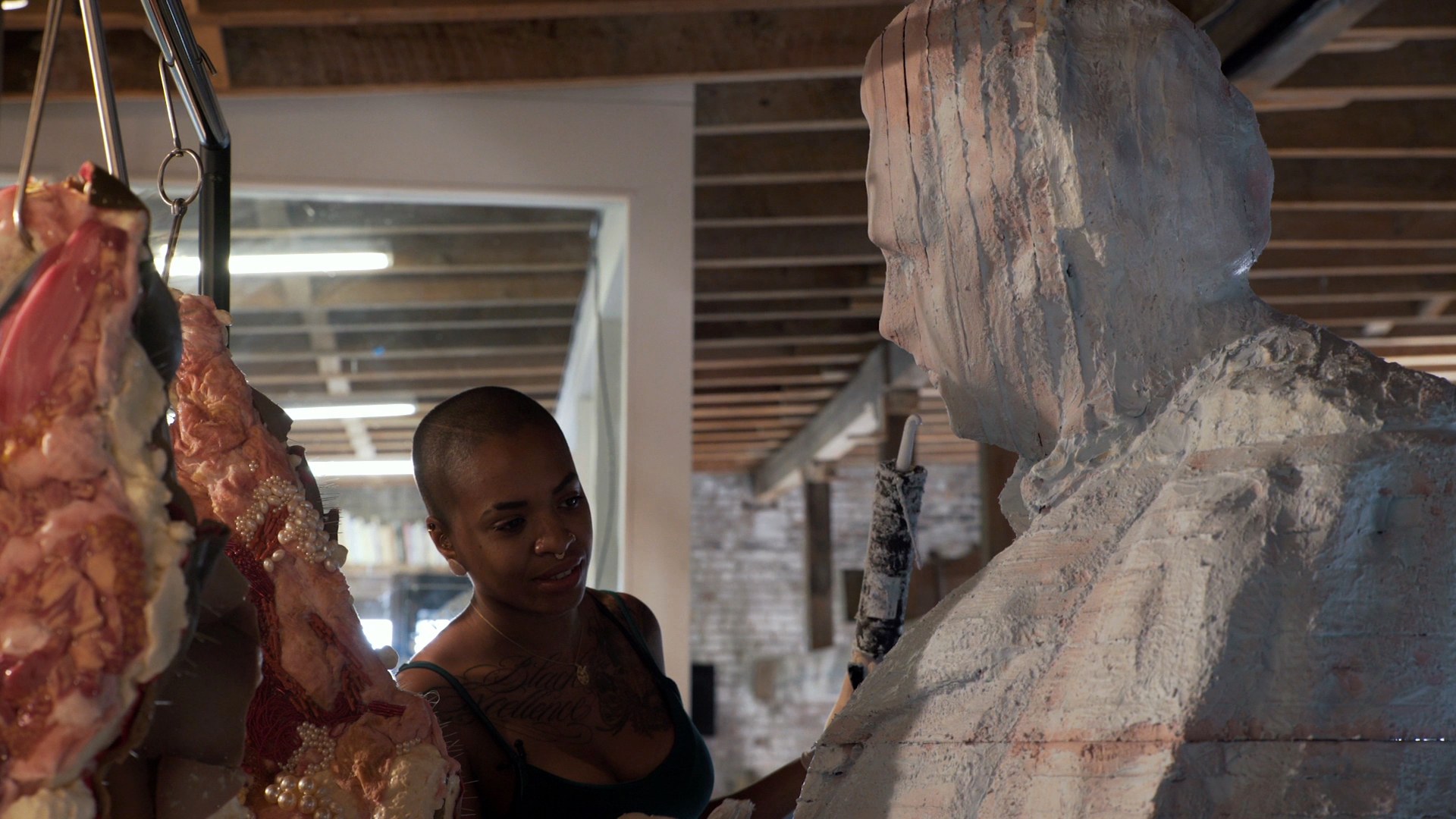
Doreen Garner at work on White Man On A Pedestal, a two-person exhibition at Pioneer Works, Brooklyn, 2017. Production still from the New York Close Up film Doreen Garner Sculpts Our Trauma. © Art21, Inc. 2018. Cinematography: Brian Redondo.
ART21: What specifically are you bringing to audiences, with this show?
DG: My work helps me to question why White men are on pedestals. Sims’s monument stands as a symbol of acceptance of hate and of racism. It’s as if his horrific acts don’t matter because we have benefited from his medical advances. But it’s not healthy to ignore the horror. I like the idea that we can deconstruct his statue. If Sims could see me, a young Black woman, cutting up [a silicone cast of his statue] as a means of entertainment for not only Black people but also White people, I think he would be horrified.
Black people have always been dehumanized by White people. In the media, Black murder is treated like snuff porn: you can watch a video of someone getting shot and killed, and nothing’s being done about it. From 1700 to 2017, racism has transformed into a different type of beast. I try to analyze what it means to dehumanize someone.
There is a history that needs to be taught and known. I try to illustrate some of the things that I’ve read, like Harriet Washington’s The Medical Apartheid, to contribute in some way to making this information unavoidable. I’m also trying to find a sparkle of hope, that people have hearts, that people are horrified and disgusted [by Sims] even if they aren’t people of color.
As an artist, I can inspire a feeling in someone who might have the power to make decisions [about monuments]. Therefore, I do have the power to change things. These conversations we’re having about monuments and statues are a wake-up call for everybody to get to the issue that’s most important: equality.
Interviewer: Brian Redondo. Content Editors: Deanna Lee and Lindsey Davis. Published: March 2018. © Art21, Inc. Artwork courtesy of the artist and Pioneer Works, Brooklyn.
An excerpt of this interview was also published in the Art21 Magazine‘s Winter 2018 issue, “Whose Public?“
